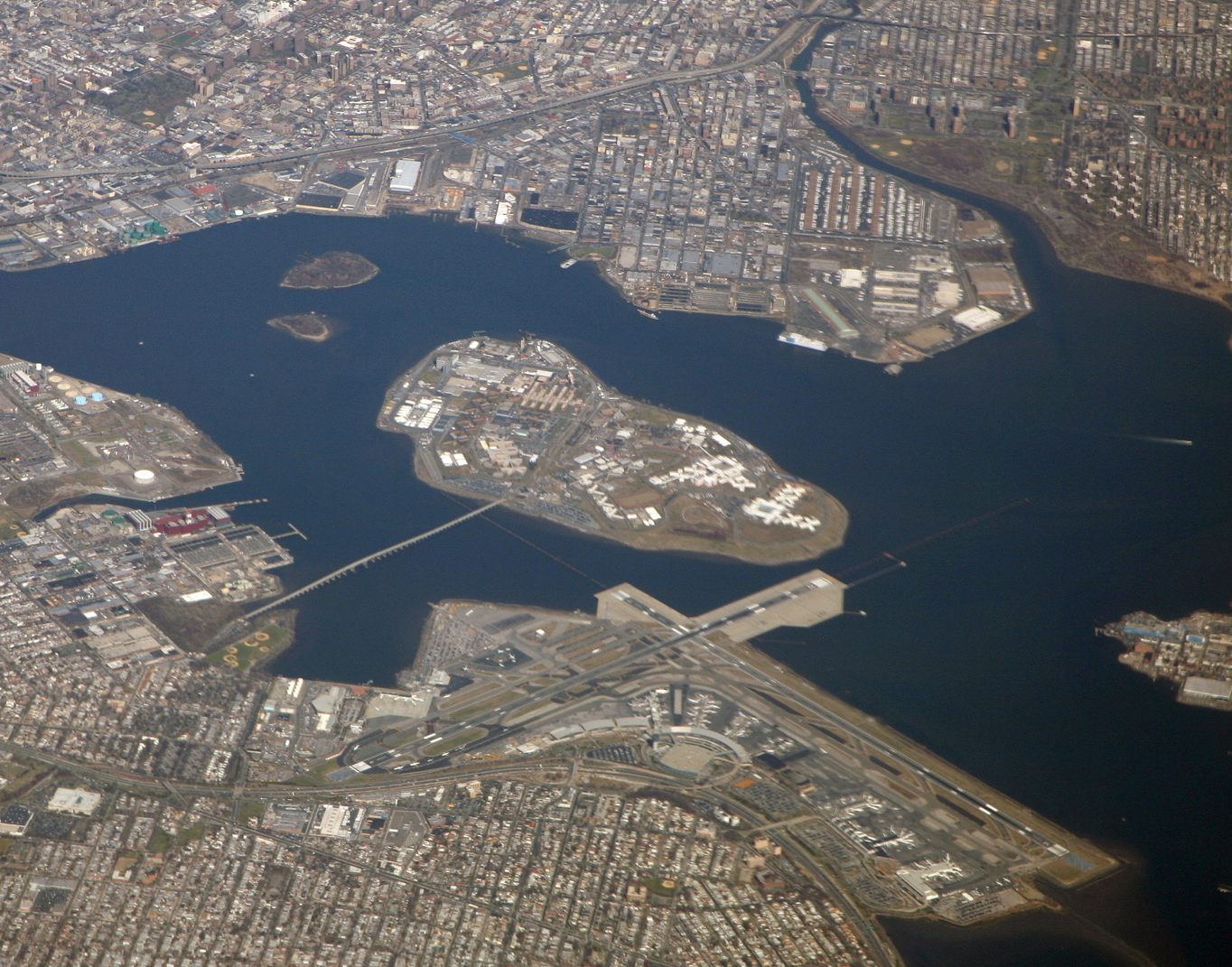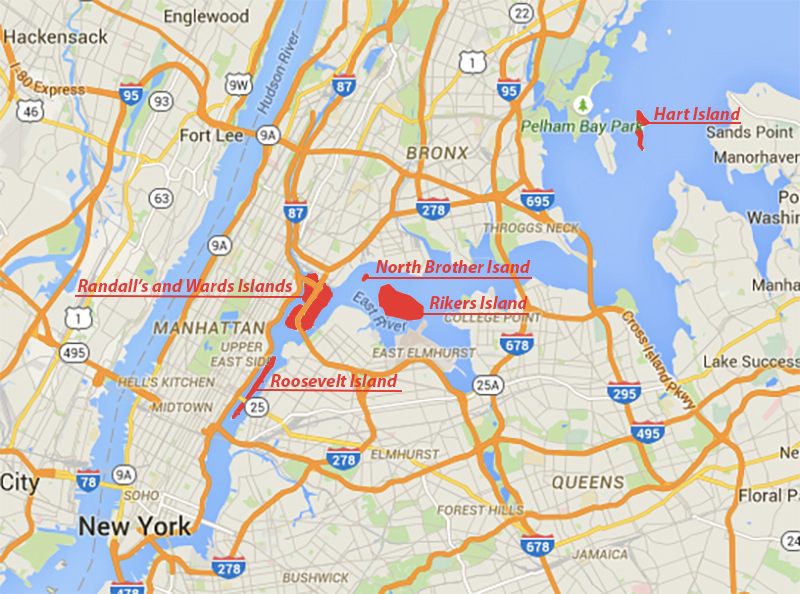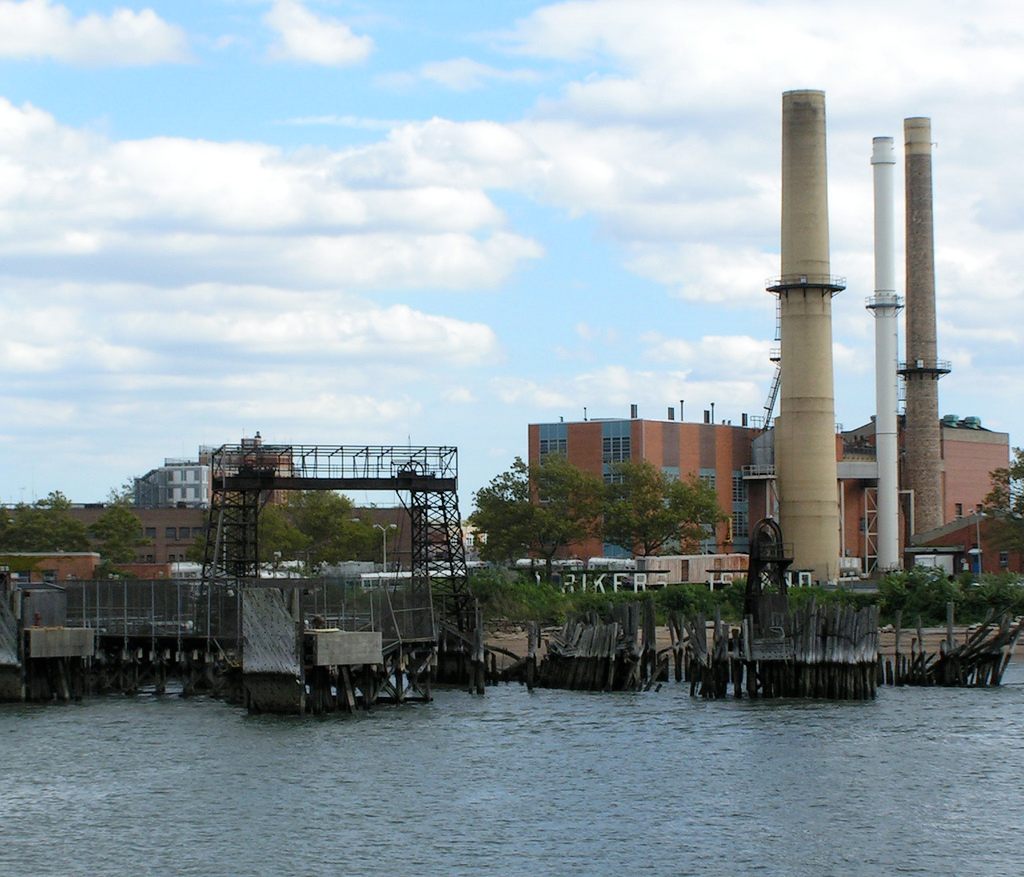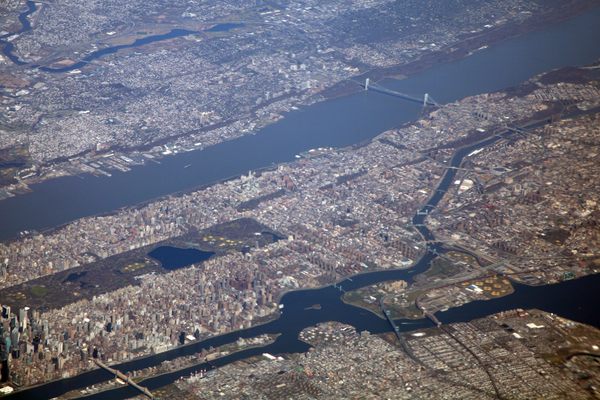Islands of The Undesirables: Rikers Island
 An Aerial of Rikers Island (Photo: Doc Searls/Flickr)
An Aerial of Rikers Island (Photo: Doc Searls/Flickr)
This is the fifth and final installment of five-part series on New York City’s tendency to put its ill, its insane, its criminals and its dead on islands around the boroughs, based on this past weekend’s Obscura Day event. Monday was Roosevelt Island, Tuesday was Randall’s Island and Wards Island, Wednesday was North Brother Island, Thursday was Hart Island, and today we look at Rikers Island.

A map of the islands that are featured in Atlas Obscura’s Islands of the Undesirables series (Photo: Map Data © 2015 Google)
Rikers Island has been in trouble from the start—or at least since the beginning of its days with European owners.
In 1664, the sheriff of Flushing, William Hallet, bought the island from the Native Americans; his unsanctioned purchase so displeased Dutch governor Peter Stuyvesant that his last act before turning the colony over to England was to give the island to a respected farmer named Abraham Rycken. The English confirmed the grant, and the Ryckens—who later changed their name to Riker—farmed on the island for generations.
But, like many of the islands of the undesirables, farming gave way to darker purposes. New York’s Department of Public Charities and Corrections bought the island in 1884 for $180,000, intending to create a new prison to replace the dilapidated, crowded, medieval-looking penitentiary on what was then Blackwell’s Island (now called Roosevelt). The motive was to make Roosevelt Island a place solely for the poor and sick, who would no longer be stigmatized by the presence of criminals.
But the new prison on Rikers—which eventually became one of the largest penal complexes in the world—didn’t open for 50 years. In the meantime, the island became a municipal farm and piggery, whose pork products later fed many of those confined to the city’s institutions. The island’s southern edge also became a landfill, in part to extend its acreage; at the time of the city’s purchase, Rikers was only about 87 acres, but garbage extended it to its present 415 acres.
Starting in 1893, the city began dumping street sweepings, horse manure, household garbage and ashes on the island, at least until the vile odor that drifted to Queens and the South Bronx drew protests. Three years later, the city contracted with a sanitation company to send the most offensive garbage to a reduction plant on Barren Island, and Rikers temporarily received the less-smelly stuff. But by the 1920s, the island was again a dumping ground for every kind of refuse, often smoking beneath a blanket of ashes. In 1926, the New York Times reported that the place “looked like a volcano preparing for an eruption.”
 The Rikers Island docks (Photo: reivax/Flickr)
The Rikers Island docks (Photo: reivax/Flickr)
Not surprisingly, Rikers soon became overrun by giant rats. When wild dogs were sent to kill them in the 1930s, they attacked the pigs instead. Some of the canines were killed, but sanitation workers refused to go near the rats without the dogs by their side. Eventually, the city killed the rats using poison gas.
The new prison finally opened in 1935 (dumping on the island ended only in 1939, in part because of that year’s World’s Fair in nearby Flushing.) The opening was greeted with much fanfare, despite charges of Tammany Hall corruption that bedeviled the later stages of its construction. The $10 million jail was considered innovative for its time, with eight cellblocks, an auditorium, and an exercise space, as well as education, employment, and medical serves for offenders. Instead of a fortress-style outer wall, there was only a wire fence with guard towers; the violent waters around the island were seen as their own form of protection.
Within only a few years, though the prison was over-crowded. The facilities were built for 2,200 inmates, by 1941, the prison population stood at 2,500. Between 1941 and 1945, the population nearly doubled. To cope, the prison staff created makeshift cells and doubled up on prisoners, but the band-aid solutions left plenty to be desired. In the 1960s and 1970s, racial violence spiraled, as did inmate suicides, and by 1971 the Department of Corrections called overcrowding “the single greatest crisis in the city prison system.” One of the worst incidents of unrest occurred in 1975, when 1,600 inmates held five officers hostage for 17 hours, threatening them with toothbrush handles embedded with razors, among other tools. During the crack epidemic, the prisoner population grew 300 percent.
 An orthophoto detailing the facilities on Rikers Island (Photo: Public Domain/WikiCommons)
An orthophoto detailing the facilities on Rikers Island (Photo: Public Domain/WikiCommons)
Today, Rikers is the Department of Corrections’ main base of operation and the primary jail complex for New York City, holding about 11,000 inmates on any given day. Most are offenders serving short sentences or those waiting to be transferred to other institutions. About two-thirds are awaiting a trial; many are there because they are too poor to make bail. The facility includes a complex of ten jails (with separate facilities for men, women, and adolescents) spread over 415 acres, and also has its own schools, medical clinics, ball fields, chapels, gyms, grocery stores, barbershops, bakery, laundromat, power plant, track, tailor shop, print shop, bus depot and car wash.
The inmates aren’t the only ones in trouble at Rikers—officers at the jail complex have been the subject of repeated scandals. The Department of Corrections has paid out millions of dollars to inmates injured on the island. In August 2014, the U.S. Attorney for the Southern District of New York issued a report condemning the systematic abuse and violation of prisoners’ constitutional rights, and there’s an ongoing class-action lawsuit against the city. Earlier this month, two women sued a Rikers corrections officer and the city of New York, alleging serial rape and sexual abuse amid city complacency.
While the scandals, stabbings, and slashing declines sharply during the mid and late 1990s, Rikers has recently been back in the news—thanks in part to a series of investigations by the New York Times and a New Yorker feature about one inmate who recently spent three years on the island after being accused of stealing a backpack.
Mayor Bill DeBlasio has vowed to improve conditions at the jail complex—but if the history of the place says anything, he has a long road ahead of him.

Buildings on Rikers Island (Photo: Sfoskett/WikiCommons CC BY-SA 3.0)






Follow us on Twitter to get the latest on the world's hidden wonders.
Like us on Facebook to get the latest on the world's hidden wonders.
Follow us on Twitter Like us on Facebook